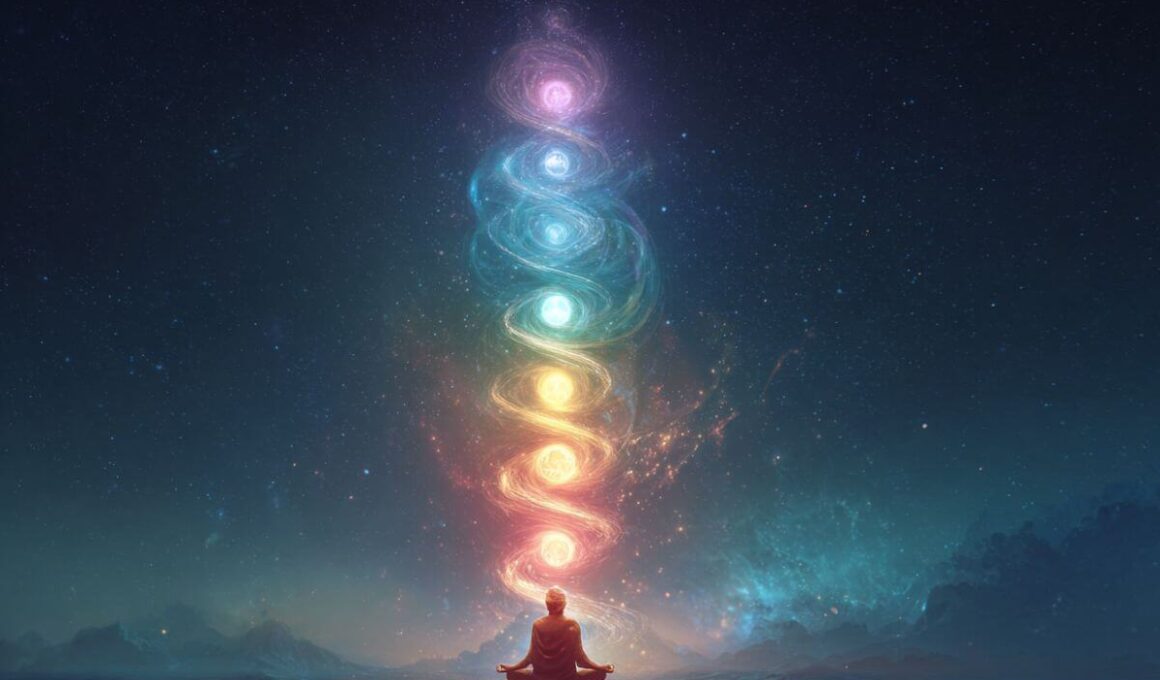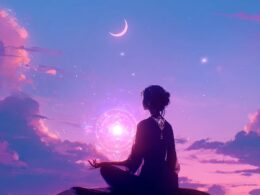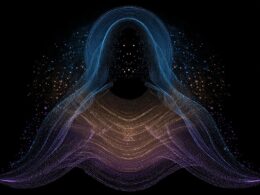For thousands of years, spiritual teachers from around the world have mapped out how human awareness grows and changes. They noticed that consciousness isn’t just one thing. Instead, it has different levels, like floors in a building. Each level gives you a totally different way of seeing and experiencing life.
The cool thing is that cultures from India to Tibet to Native America all came up with very similar maps. They might use different words, but they’re describing the same basic journey from ordinary everyday awareness all the way up to the highest spiritual states.
This guide walks you through the seven main levels that almost every tradition talks about. Think of it as a roadmap for understanding where you are now and where consciousness can go.
Level 1: Waking Consciousness
This is where most people spend most of their time. It’s your normal everyday awareness when you’re awake and going about your day. Your mind is active with thoughts, feelings come and go, and you take in information through your five senses.
At this level, you probably feel like you ARE your thoughts and emotions. When something good happens, you feel happy. When something bad happens, you feel upset. Your mood goes up and down based on what’s happening around you. You see yourself as separate from other people and things in the world.
This level isn’t bad or wrong. It’s actually necessary for functioning in daily life. You need this kind of awareness to drive a car, have conversations, and get things done. But spiritual traditions say this is just the starting point, not the whole story.
What It Feels Like
Most of your life happens in waking consciousness. You experience feelings, see things with your eyes, hear sounds, remember stuff from the past, and make decisions based on all this information. Your attention moves from one thing to another throughout the day.
The tricky part is that you usually think this everyday awareness is all there is. You might not even realize there are other ways to experience life. It’s like living in a house and not knowing there are other floors above you.
Different Traditions Say
Hindu teachers call this the “jagrat” state. It’s bound by what they call the three gunas, which are basically different qualities of nature that keep you tied to the physical world. Buddhist teachings focus on how the first six types of consciousness (your five senses plus your thinking mind) create this everyday experience.
David Hawkins, who created a detailed map of consciousness levels, puts most of everyday human experience between levels 20 and 400 on his scale. This includes everything from depression and anger up through logical thinking.
Moving Beyond This Level
The key to growing beyond ordinary waking consciousness is learning to step back and watch your thoughts and feelings instead of being completely caught up in them. Meditation is probably the most common way to do this. When you sit quietly and observe your mind, you start to realize that you’re not actually your thoughts. You’re the one watching them.
Other helpful practices include asking yourself deep questions like “Who am I really?” and doing things to help others, which naturally takes your focus off your personal problems and concerns.
Level 2: Dreaming Consciousness
This is the awareness you have when you’re asleep and dreaming. Most people don’t think much about dreams, but spiritual traditions consider this a really important level of consciousness. Dreams aren’t just random brain activity. They’re actually a window into deeper parts of your mind.
In dreams, the normal rules don’t apply. You can fly, talk to people who have died, or find yourself in impossible situations. Time and space work differently. Your logical mind isn’t running the show, so symbolic and intuitive ways of knowing take over.
What It Feels Like
When you’re dreaming, it usually feels completely real while it’s happening. You might have emotional reactions, make decisions, and interact with dream characters just like you would in waking life. But when you wake up, the experience often seems strange or hard to remember.
Some people have dreams that feel especially meaningful. Maybe you get an answer to a problem you’ve been struggling with, or you have a conversation with a deceased relative that brings you comfort. These experiences hint at the deeper intelligence that’s available through dream consciousness.
Different Traditions Say
Hindu philosophy calls this the “svapna” state. They see it as the subtle body’s way of experiencing reality, which is less dense than physical reality but more solid than pure consciousness. Tibetan Buddhists have developed elaborate practices called “dream yoga” to use dreams for spiritual growth.
Many shamanic traditions consider dreams to be just as real and important as waking life. Some shamans are born with natural abilities to travel between different realms through their dreams and bring back information that helps their communities.
Working With This Level
You can learn to remember your dreams better by keeping a journal next to your bed and writing down whatever you remember as soon as you wake up. Some people develop the ability to become aware that they’re dreaming while still in the dream. This is called lucid dreaming, and it opens up amazing possibilities for spiritual practice.
Dreams often speak in symbols and metaphors, so learning to understand this symbolic language can give you insights into your deeper psyche and spiritual development.
Level 3: Deep Sleep Consciousness
This might seem like a strange thing to call a level of consciousness since you’re not conscious of anything during deep sleep. But spiritual traditions say this state is actually really important for understanding higher levels of awareness.
During deep sleep, your ego mind completely shuts down. There are no thoughts, no dreams, no sense of being a separate individual. In a way, your personal self temporarily dissolves. Yet something in you continues to exist, which is why you wake up as the same person.
What It Feels Like
By definition, you don’t experience anything during deep sleep. There’s no awareness of time passing, no thoughts or feelings, and no sense of being an individual person. It’s like you temporarily stop existing as a separate self.
But here’s the interesting part: you wake up feeling rested and refreshed. Something was happening during that time, even though you weren’t aware of it. Your body was healing, your brain was processing information, and in some mysterious way, your consciousness was recharging.
Different Traditions Say
Hindu teachings call this “sushupti” and consider it the closest thing to pure consciousness that most people experience regularly. Every night, you temporarily merge with the universal awareness that underlies all existence.
In Transcendental Meditation, teachers explain that during deep sleep, your nervous system gets the deepest possible rest. Stress hormones drop to their lowest levels, growth hormones are released for healing, and your whole system resets itself.
Why This Matters
Deep sleep shows you that it’s possible for your ego mind to completely disappear while something deeper continues to exist. This gives you a taste of what the higher spiritual states are like, where individual identity dissolves into something much larger.
Think of it as a daily practice session for ego death. Every night, you let go of being a separate person and merge with pure being. Most people just don’t realize that’s what’s happening.
Level 4: Transcendental Consciousness
This is where things get really interesting. Transcendental consciousness is the first of what spiritual traditions call the “enlightened states.” It’s when you access pure awareness that exists beyond thinking, while still being completely awake and alert.
Imagine being fully conscious but having your mind be completely quiet. No thoughts, no mental chatter, just pure awareness itself. You’re not thinking about anything, but you’re more awake than you’ve ever been. This isn’t spacing out or being absent. It’s the opposite. You’re totally present, just without any mental activity.
What It Feels Like
People describe this state as deeply peaceful and restful, but also incredibly alert. It’s like being plugged into the source of consciousness itself. Many people say it feels like coming home to who they really are underneath all their thoughts and personality.
During transcendental consciousness, you might lose all sense of time. What feels like a few minutes could actually be an hour, or what feels like a long time might only be a few moments. The boundaries between yourself and everything else start to get fuzzy.
Different Traditions Say
Hindu philosophy calls this “turiya,” which means the fourth state beyond waking, dreaming, and sleeping. It’s considered your true nature that’s always present but usually covered up by mental activity.
In Buddhism, this relates to deep meditation states called “samadhi,” where the mind becomes completely absorbed in pure awareness. Christian mystics describe similar experiences during contemplative prayer, where they feel united with divine consciousness.
Transcendental Meditation teachers describe this as “pure consciousness” or “restful alertness.” They say it’s not really a special state you have to create, but rather your natural state of being when all the mental activity settles down.
How To Access This Level
The most reliable way to experience transcendental consciousness is through meditation, especially techniques that help your mind naturally settle down rather than trying to force it to be quiet. Many people also access it through deep prayer, spending time in nature, or during peak experiences.
The key is learning to let go rather than trying to make something happen. The more you strain or effort, the more you stay stuck in thinking mode. This state emerges naturally when you relax deeply enough.
Level 5: Cosmic Consciousness
This is a major milestone in spiritual development. Cosmic consciousness means that the pure awareness you experience in transcendental consciousness becomes permanently established. It’s running in the background 24/7, even when you’re thinking, talking, working, or sleeping.
At this level, you realize that you are not your thoughts, emotions, or body. You are the unchanging awareness that observes all these things. No matter what happens in your life, there’s a part of you that remains completely peaceful and unaffected.
What It Feels Like
Imagine having a deep inner peace that never goes away, no matter what’s happening around you. You could be dealing with stressful situations, but underneath it all, there’s this unshakeable calm. It’s like discovering that you have a safe, quiet room inside yourself that you can always access.
People at this level often describe feeling like they’re watching their life happen rather than being completely caught up in it. They still have emotions and reactions, but they’re not controlled by them. There’s always this witness part of them that stays centered and clear.
The fear of death usually disappears because you realize that what you really are can’t die. Your body and personality might change or end, but the core awareness that you are is eternal.
Different Traditions Say
In Hindu tradition, this is called “sahaja samadhi,” which means natural or effortless enlightenment. Advaita Vedanta teachers call it “jivanmukti,” meaning liberation while still living in a body.
Buddhist teachings describe this as the first major stage of awakening, called “stream entry.” Once you reach this level, you’re guaranteed to reach full enlightenment within seven lifetimes at most.
David Hawkins describes this as the level where psychological suffering essentially ends. You might still experience physical pain or challenging situations, but you don’t create mental and emotional suffering about them.
Living From This Level
People with cosmic consciousness often seem very calm and happy for no particular reason. They’re not trying to get anything or become anyone different. They’ve found a deep contentment that doesn’t depend on external circumstances.
They usually become naturally compassionate because they see that everyone is struggling with the same basic misunderstanding about who they really are. This often leads to wanting to help others wake up to their true nature.
Level 6: God Consciousness
At this level, something beautiful happens. The pure awareness of cosmic consciousness expands to include a refined perception of the divine essence in everything. The world doesn’t just look normal anymore. Everything appears radiant, alive, and filled with love.
It’s like someone turned up the brightness and beauty settings on reality. Colors seem more vivid, sounds more harmonious, and even ordinary objects can appear to glow with inner light. You start to see the sacred in everything, from a flower to a stranger’s face.
What It Feels Like
People at this level often describe waves of overwhelming love and devotion that arise spontaneously. You might look at a tree and feel such intense love for it that you start crying. Or you could be doing something completely ordinary like washing dishes and suddenly be filled with gratitude for the miracle of existence.
Many people report literally seeing light around living beings, like a subtle glow or aura. Sounds might seem more beautiful and musical. It’s as if the divine beauty that was always there becomes visible and tangible.
The heart feels like it’s constantly overflowing with love, not just for people you care about, but for existence itself. There’s often a deep devotion to God or the divine, even in people who weren’t particularly religious before.
Different Traditions Say
In Hindu tradition, this relates to refined bhakti or devotional consciousness. The heart opens so fully that you see God in everything and feel constant love and worship arising naturally.
Christian mystics describe this as unitive consciousness, where you see Christ or divine love in all beings. Sufi teachings call it “baqa,” which means remaining in divine consciousness after the ego has dissolved.
In Transcendental Meditation, they explain that this happens when the nervous system becomes so refined that it can perceive subtler levels of creation that are normally invisible to the senses.
How This Changes Your Life
Everything becomes worship. Whether you’re gardening, cooking, or talking to someone, it all feels like acts of devotion. Many people at this level are drawn to artistic expression, healing work, or other ways of sharing the beauty they perceive.
Relationships become much deeper because you see the divine essence in every person. You might find yourself feeling compassion even for people who are behaving badly because you can see their essential innocence underneath their confusion.
Level 7: Unity Consciousness
This is the highest level of human consciousness that spiritual traditions describe. At unity consciousness, the last traces of separation completely disappear. You don’t just understand intellectually that everything is one. You actually experience yourself as the one consciousness that appears as everything in the universe.
It’s not that you become one with everything. You realize that you always were everything, and you just didn’t know it before. The sense of being a separate individual inside a body completely dissolves, but paradoxically, you’re more yourself than you’ve ever been.
What It Feels Like
Words really can’t capture this experience, but imagine if you suddenly realized that you are every person, every animal, every plant, every star, and every grain of sand. Not just connected to them, but literally being them. You are the one consciousness looking out through every pair of eyes and experiencing itself as all of existence.
There’s no sense of personal will or agenda anymore because you realize there’s only one will, which is the universe expressing itself through apparent individual forms. Actions happen spontaneously based on what the moment requires, without any sense of someone making decisions.
The joy and peace at this level are beyond description. It’s not happiness about something. It’s the joy of being itself, which is what you discover yourself to be.
Different Traditions Say
Advaita Vedanta describes this as the ultimate realization: “Tat tvam asi” or “That thou art.” You realize that the individual self you thought you were is actually the same consciousness that appears as the entire universe.
In Kashmir Shaivism, this is recognizing your own nature as Shiva, the universal consciousness that dances as all of creation. Buddhist teachings describe this as full Buddha nature awakening, where you realize that your mind and the Buddha’s mind are exactly the same.
According to David Hawkins’ research, very few people in human history have reached this level. He claimed that at the time he wrote his books, only about six people had calibrated at this highest level.
Living From This Perspective
People at this level often seem very ordinary on the outside, but their presence has an extraordinary effect on others. They naturally radiate peace and love without trying to do anything special.
Since they see themselves in everyone, they’re naturally compassionate and helpful. But it doesn’t feel like work or sacrifice because they’re literally serving themselves when they serve others. Every action becomes an expression of love for the whole.










